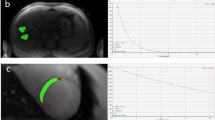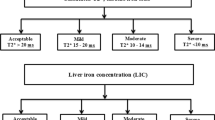Abstract
The aim of the study is to assess the relationship between T2* magnetic resonance imaging (MRI) values and age, serum ferritin level, left ventricular ejection fraction (LVEF), splenectomy status, and to identify appropriate modifications to chelation therapy based on T2* MRI results of children with thalassaemia major. Sixty-four patients with thalassaemia major (37 girls/27 boys) older than 8 years of age were enrolled in the study. Based on the first T2* MRI, the patients’ myocardial iron depositions were classified into three groups: T2* MRI <10 ms (high risk group), T2* MRI 10–20 ms (medium-risk group) and T2* MRI >20 ms (low-risk group). There was no significant relationship between T2* MRI value and ages, serum ferritin levels and splenectomy status of thalassaemia major patients. The mean LVEFs were 60, 75, and 72.5 % in the high-, medium-, and low-risk groups, respectively (P = 0.006). The mean cardiac iron concentrations calculated from the T2* MRI values were 4.96 ± 1.93, 1.65 ± 0.37, and 0.81 ± 0.27 mg/g in the high-, medium-, and low-risk groups, respectively. Chelation therapies were re-designed in 24 (37.5 %) patients according to cardiac risk as assessed by cardiac T2* MRI. In conclusion, until recently, T2* MRI has been employed to demonstrate cardiac siderosis without a direct relationship with the markers used in follow-up of patients with thalassaemia. However, modifications of chelation therapies could reliably be planned according to severity of iron load displayed by T2* MRI.




Similar content being viewed by others
References
Aydinok Y. Thalassemia. Hematology. 2012;17(1):S28–31.
Borgna-Pignatti C, Rugolotto S, De Stafano P, et al. Survival and complications in patients with transfusion and deferoxamine. Haematologica. 2004;89:1187–93.
Tanner MA, Galanello R, Dessi C, et al. Myocardial iron loading in patients with thalassemia major on deferoxamine chelation. J Cardiovasc Magn Reson. 2006;8:543–7.
Kirk P, Raughton M, Porter JB, et al. Cardiac T2* magnetic resonance for prediction of cardiac complications in thalassemia major. Circulation. 2009;120:1961–8.
Pennel DJ. T2* magnetic resonance and myocardial iron in thalassemia. Ann NY Acad Sci. 2005;1054:373–8.
Anderson LJ, Holden S, Davies B, et al. Cardiovascular T-star (T2*) magnetic resonance for the early diagnosis of myocardial iron overload. Eur Heart J. 2001;22:2171–9.
Tanner MA, Porter JB, Westwood MA, et al. Myocardial T2* in patients with cardiac failure secondary to iron overload. Blood. 2005;106:406.
Westwood M, Anderson LJ, Firmin DN, et al. A single breath-hold multiecho T2* cardiovascular magnetic resonance technique for diagnosis of myocardial iron overload. J Magn Reson Imaging. 2003;18(1):33–9.
Wood JC. Impact of iron assessment by MRI. Hematol Am Soc Hematol Educ Program. 2011;2011:443–50.
Carpenter JP, He T, Kirk P, et al. On T2* magnetic resonance and cardiac iron. Circulation. 2011;123(14):1519–28.
Consensus view on choice or iron chelation therapy in transfusional iron overload for inherited anemias. http://www.emscg.nhs.uk/Library/NUHGuidelinesforironchelationtherapy.pdf. Accessed 3 May 2012.
Modell B, Khan M, Darlison M, et al. Survival in beta-thalassemia major in the UK: data from the UK Thalassemia Register. Lancet. 2000;355:2051–2.
Borgna-Pignatti C, Cappellini MD, De Stafano P, et al. Survival and complications in thalassemia. Ann NY Acad Sci. 2005;1054:40–7.
Modell B, Khan M, Darlison M, et al. Improved survival of thalassemia major in the UK and relation to T2* cardiovascular magnetic resonance. J Cardiovasc Magn Reson. 2008;25:10–42.
Pepe A, Meloni A, Capra M, et al. Deferasirox, deferiprone and desferrioxamine treatment in thalassemia major patients: cardiac iron and function comparison determined by quantitative magnetic resonance imaging. Haematologica. 2011;96(1):41–7.
Pennell DJ, Berdoukas V, Karagiorga M, et al. Randomized controlled trial of deferiprone or deferoxamine in beta-thalassemia major patients with asymptomatic myocardial siderosis. Blood. 2006;107:3738–44.
Pennell DJ, Porter JB, Capellini DM, et al. Efficacy and safety of Deferasirox (Exjade®) in reducing kardiyac iron in patients with beta-thalassemia major: results from the cardiac substudy of the EPIC trial. Blood. 2008;112:3873.
Aydınok Y, Levent E, Bayraktaroğlu S, et al. Talasemi major olgularında kardiyak demir birikiminin başlangıç yaşı, kardiyak fonksiyonlar, karaciğer demir yoğunluğu ve serum ferritin düzeyleri ile ilişkisi. Ulusal Pediatrik Hematoloji Kongresi, 2009.
Wood JC, Origa R, Agus A, et al. Onset of cardiac iron loading in pediatric patients with thalassemia major. Haematologica. 2008;93:917–20.
Kwiatkowski JL. Real-world use iron chelators. Hematol Am Soc Hematol Educ Program. 2011;2011:451–8.
Wood JC, Tyszka JM, Carson S, et al. Myocardial iron loading in transfusion-dependent thalassemia and sickle cell disease. Blood. 2004;103(5):1934–6.
Aydinok Y, Bayraktaroglu S, Yildiz D, et al. Myocardial iron loading in patients with thalassemia major in Turkey and the potential role of splenectomy in myocardial siderosis. J Pediatr Hematol Oncol. 2011;33:374–8.
Thalassemia International Federation 2008. http://www.thalassaemia.org.cy/pdf/Guidelines_2nd_revised_edition_EN.pdf. Accessed 15 Nov 2011.
Angelucci E, Barosi G, Camaschella C, et al. Italian Society of Hematology practice guidelines for the management of iron overload in thalassemia major and related disorders. Haematologica. 2008;93:741–52.
Kolnagou A, Kontoghiorghes GJ. Effective combination therapy of deferiprone and deferoxamine for the rapid clearance of excess cardiac IRON and the prevention of heart disease in thalassemia. The Protocol of the International Committee on Oral Chelators. Hemoglobin. 2006;30:239–49.
Pennell DJ, Porter JB, Cappellini MD, et al. Efficacy of deferasirox in reducing and preventing cardiac iron overload in beta-thalassemia. Blood. 2010;115:2364–71.
Pennell DJ, Porter JB, Cappellini MD, et al. Continued improvement in myocardial T2* over two years of deferasirox therapy in β-thalassemia major patients with cardiac iron overload. Haematologica. 2011;96:48–54.
Pennell DJ, Porter JB, Cappellini MD, et al. Deferasirox for up to 3 years leads to continued improvement of myocardial T2* in patients with β-thalassemia major. Haematologica. 2012;97:842–8.
Wood JC, Thompson AA, Paley C, et al. Deferasirox (Exjade®) monotherapy significantly reduces cardiac iron burden in chronically transfused beta-thalassemia patients: an MRI T2* study. Blood. 2008;112:3882.
Tanner MA, Galanello R, Dessi C, et al. A randomized, placebo-controlled, double-blind trial of the effect of combined therapy with deferoxamine and deferiprone on myocardial iron in thalassemia major using cardiovascular magnetic resonance. Circulation. 2007;115:1876–84.
Hoffbrand AV, Taher A, Cappellini MD. How I treat transfusional iron overload. Blood. 2012;120(18):3657–69.
Conflict of interest
None stated.
Author information
Authors and Affiliations
Corresponding author
Additional information
All authors contributed to data collection and drafting the paper.
Electronic supplementary material
Below is the link to the electronic supplementary material.
12185_2014_1575_MOESM1_ESM.docx
Web Table 1: General characteristics of the patients with therapy modifications made after T2* MRI. (DOCX 13 kb)
About this article
Cite this article
Akcay, A., Salcioglu, Z., Oztarhan, K. et al. Cardiac T2* MRI assessment in patients with thalassaemia major and its effect on the preference of chelation therapy. Int J Hematol 99, 706–713 (2014). https://doi.org/10.1007/s12185-014-1575-1
Received:
Revised:
Accepted:
Published:
Issue Date:
DOI: https://doi.org/10.1007/s12185-014-1575-1




